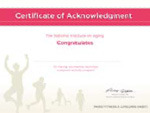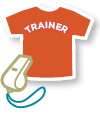We hope you agree that regular exercise and physical activity are important and that you’re ready to take action! This chapter is all about getting organized. It offers tips for setting short- and long-term goals, choosing activities and fitting them into your daily life, and managing some of the practical things, such as getting the right shoes or working with a personal trainer.
This guide’s main goal is to help you become more active, get the most from your activities, and do them safely. The key is to know your starting point and build slowly from there. Knowing your starting point will help you pick activities that are comfortable and realistic for you. Starting out this way also will help you be successful.
 Identifying Your Starting Point
Identifying Your Starting Point
Think about a typical weekday and weekend day. How much time do you spend sitting? How much time are you active? When you’re up and moving, what kinds of activities are you doing?
To help you figure out your activity level, try filling in an activity log. For a couple of weekdays and a weekend, keep track of how much time you exercise or are physically active. Write down how much time you spend doing each activity. The Activity Log in Chapter 7 will get you started.
You can use the last column of the Activity Log to write down some ways you think you can add activities to your daily routine. If you’re not active yet, aim for a modest beginning and build from there. If you are already pretty active, then you can be more ambitious about adding to your activities.
|
 |
go here for more info
If you need to jog your memory, go back to Chapter 1 and look at the examples of the four types of exercise. Also, review Exercise and Everday Activities Go Together in Chapter 1. |
|
|

There are many ways to fit exercise and physical activity into your regular routine:
 Try something new: If you baby-sit for your grandchildren, how about walking to the park instead of playing video games? Try something new: If you baby-sit for your grandchildren, how about walking to the park instead of playing video games?
 Rethink your priorities: How important is an entire afternoon of TV? How about a walk after lunch instead? Rethink your priorities: How important is an entire afternoon of TV? How about a walk after lunch instead?
 Work harder at the things you already do: Rake the leaves instead of using the leaf blower. Work harder at the things you already do: Rake the leaves instead of using the leaf blower.
|
 Setting Your Goals
Setting Your Goals
Many people find that having a firm goal in mind motivates them to move ahead on a project. Goals are most useful when they are specific, realistic, and important to you. Consider both short- and long-term goals. Your success depends on setting goals that really matter to you. Write down your goals, put them where you can see them, and review them regularly.
In addition to seeing how physically active you are now, you can check how fit your body is. Several simple tests can help you see how fit you are right now (see "Test Yourself" in Chapter 5). The results can help you set realistic goals. They also will be useful later on to measure your progress.
Short-term goals will help you make physical activity a regular part of your daily life. For these goals, think about the things you’ll need to get or do in order to be physically active. For example, you may need to buy walking shoes or fill out an Activity Log so you can figure out how to fit physical activity into your busy day. Make sure your short-term goals will really help you be active. Here are a few examples of short-term goals:
- Today, I will decide to be more active.
- Tomorrow, I will find out about exercise classes in my area.
- By the end of this week, I will talk with my friend about exercising with me a couple of times a week.
- In the next 2 weeks, I will make sure I have the shoes and comfortable clothes I need to start walking.
If you’re already active, think of short-term goals to increase your level of physical activity. For example, over the next week or two, you may want to move gradually from walking to jogging, increase the amount of weight you lift, or try a new kind of physical activity. No matter what your starting point, reaching your short-term goals will make you feel good and give you confidence to progress toward your long-term goals. Use the Goal-Setting Worksheet in Chapter 7 to help you get started.
After you write down your short-term goals, you can go on to identify your long-term goals. Focus on where you want to be in 6 months, a year, or 2 years from now. Long-term goals also should be realistic, personal, and important to you. Here are a few examples:
- By this time next year, I will swim a mile three times a week.
- Next summer, I will be able to play ball with my grandchildren.
- In 6 months, I will have my blood pressure under control by increasing my physical activity and following my doctor’s advice.
Add your own long-term goals to the Goal-Setting Worksheet.

For Sam, "being able to do the things I enjoy doing” motivates him to exercise every day:
"I started exercising regularly way back in 1960. A friend put me in touch with a personal trainer at a nearby gym, and he showed me how to lift weights. Today, at age 83, I’m still exercising to stay fit. I get up every day and exercise for 10 to 15 minutes. I lift weights followed by stretching. In the evening, I do the same routine for about 15 minutes. I’m a drummer by profession, and I do about four gigs a month. Exercise keeps my muscles strong and lets me continue to do my drumming."
|

Don’t forget to build rewards into your plan. For each goal you reach, treat yourself to something special — a movie, a trip to a museum, a new CD, or a picnic in the park.
Let us help you celebrate your progress! If you increase your physical activity for more than a month, send us the form included with this guide. We’ll send you a certificate from the National Institute on Aging to recognize your commitment. |
 Writing a Plan to Add Exercise and Physical Activity to Your Life
Writing a Plan to Add Exercise and Physical Activity to Your Life
Some people find that writing an exercise and physical activity plan helps them keep their promise to be active. See if this works for you. Be sure the plan is realistic for you to do, especially as you gain experience in how to be active. You might even make a contract with a friend or family member to carry out your plan. Involving another person can help you keep your commitment.
Make your plan specific and grounded in your goals. For each exercise or activity you choose, include:
- What kind of activity you plan to do
- Why you want to do it
- When you will do it
- Where you will do it
Start out with realistic activities based on how physically active you are now. Don’t expect to go from couch potato to super athlete right away. Regularly review and update your plan and long-term goals so that you can build on your success. You can use the Weekly Exercise and Physical Activity Plan in Chapter 7 to write down your activities.
When it comes to motivation, the first few months are crucial. If you can stick with physical activities you enjoy, it’s a good sign that you will be able to make exercise and physical activity a regular part of your everyday life.
Talking With Your Doctor About Exercise and Physical Activity
Most older people don’t have health problems that would prevent them from doing moderate activity or the types of exercises described in this guide. In fact, there’s a way for almost every older adult to exercise safely and get meaningful health benefits.
 You may want to talk with your doctor, however, if you aren’t used to energetic activity and you want to start a vigorous exercise program or significantly increase your physical activity. You also should talk with your doctor if you have any of the health problems mentioned below. This does not mean that exercise is dangerous. Doctors rarely tell people not to exercise, but they may have certain safety tips for those who have recently had hip or back surgery, those with uncontrolled health problems, or those with chronic conditions such as diabetes, heart disease, or arthritis.
You may want to talk with your doctor, however, if you aren’t used to energetic activity and you want to start a vigorous exercise program or significantly increase your physical activity. You also should talk with your doctor if you have any of the health problems mentioned below. This does not mean that exercise is dangerous. Doctors rarely tell people not to exercise, but they may have certain safety tips for those who have recently had hip or back surgery, those with uncontrolled health problems, or those with chronic conditions such as diabetes, heart disease, or arthritis.
Your activity level is an important topic to discuss with your doctor as part of your ongoing preventive health care. Talk about exercise at least once a year if your health is stable, and more often if your health is getting better or worse over time so that you can adjust your exercise program. Your doctor can help you choose activities that are best for you and reduce any risks. Here are a few things you may want to discuss:
- Ask whether there are exercises or activities you should avoid. An illness or surgery may affect how you exercise. For example, if you’ve had hip or back surgery, you may need to modify or avoid some exercises, or if you develop blood clots in your legs, you will have to restrict your activity for a time. Your doctor can tell you how to increase your physical activity gradually as you recover.
- Talk about any unexplained symptoms, such as chest pain or pressure, pain in your joints, dizziness, or shortness of breath. Postpone exercise until the problem is diagnosed and treated. (See "Plan for Breaks in the Routine" in Chapter 3 about getting back to regular exercise after a break.)
- Make sure your preventive care is up to date. For example, women age 65 and older should have regular tests for osteoporosis. Weight-bearing exercises — such as walking and lifting weights — are especially helpful for those with osteoporosis.
- Understand how any ongoing health conditions affect exercise and physical activity. For example, people with arthritis may need to avoid some types of activity, especially when joints are swollen or inflamed. Those with diabetes may need to adjust their daily schedule, meal plan, or medications when planning their activities.
- Talk to your doctor if you think you might have an uncontrolled medical condition that might affect the type of exercise you should be doing. For example, it is important to know how to exercise safely if your blood pressure or diabetes is not under control.
|

Some people with diabetes may need special shoes or shoe inserts to prevent serious foot problems. Medicare may pay some of the costs. Your doctor or podiatrist can tell you how to get these special shoes.
|
 Safety First: When to Check with Your Doctor
Safety First: When to Check with Your Doctor
Almost anyone, at any age, can do some type of exercise and physical activity. You can still be active even if you have a long-term condition like heart disease or diabetes. In fact, exercise and physical activity may help. But, talk with your doctor if you aren’t used to energetic activity. Other reasons to check with your doctor before you exercise include:
- Any new symptom you haven’t yet discussed
- Dizziness or shortness of breath
- Chest pain or pressure
- The feeling that your heart is skipping, racing, or fluttering
- Blood clots
- An infection or fever with muscle aches
- Unplanned weight loss
- Foot or ankle sores that won’t heal
- Joint swelling
- A bleeding or detached retina, eye surgery, or laser treatment
- A hernia
- Recent hip or back surgery
| Getting the Right Shoes
Your shoes are an important part of your physical activity routine. Remember, you’re going to be wearing them a lot. Here are a few pointers to keep in mind:
- Choose shoes that are made for the type of physical activity you want to do (walking, running, dancing, bowling, tennis).
- Look for shoes with flat, non-skid soles; good heel support; enough room for your toes; and a cushioned arch that’s not too high or too thick.
- Make sure your shoes fit well and provide proper support for your feet. This is especially important if you have diabetes or arthritis. Shoes should feel comfortable right from the start.
- Think of your shoes as safety equipment for your feet. Check them regularly, and replace them when they’re worn out. You can tell you need new shoes when:
- The tread on the bottom is worn down
- Your feet (especially your arches) feel tired after activity
- Your shins, knees, or hips hurt after activity
|
 Finding a Personal Trainer Who’s Right For You
Finding a Personal Trainer Who’s Right For You
If you’re not used to exercising, you may want to work with a personal fitness trainer. One of the best ways to find a personal trainer is to get a referral from someone you know who has a great trainer. Ask your friends and family or your health care provider. You also can check with a local health club or senior center. Once you have a couple of names, here are a few questions to help you pick the right person. If you can answer YES to most of these questions, you’re probably on the right track.
| |
Yes |
No |
| Education and Experience |
|
|
| Does the trainer have a certification from an accredited organization? For groups that certify personal trainers, exercise specialists, and fitness instructors, see National Commission for Certifying Agencies in the Resources section. |
|
|
| Does the trainer have education or experience in exercise science, aging, and program design? |
|
|
| Does the trainer have at least 2 years of experience, including experience training people your age? |
|
|
| Will the trainer be able to develop an exercise program based on your goals, abilities, and health? |
|
|
| Has the trainer worked with people with your medical conditions? |
|
|
| Does the trainer know how to personalize your exercises based on medications you take? |
|
|
| Personality |
|
|
| Did the trainer listen carefully to you and answer your questions? |
|
|
| Does the trainer have a sense of humor and a personality that you like? |
|
|
| Business Practices |
|
|
| Has the trainer told you what to expect from the sessions? |
|
|
| Are the costs of the sessions and the cancellation policy clearly stated? |
|
|
| Is the trainer insured or bonded? |
|
|
| Will the trainer give you a list of clients so you can check references? |
|
|
<<Back | Next >>
